You’ve probably heard a lot in the news lately about people buying “stuff” on the Internet.
Somebody “bought” Nyan Cat for $600,000, a Tweet by Jack Dorsey for $3M, and a picture of Lindsay Lohan’s face for $50,000.
These people don’t own the copyright to these items, nor do they receive anything physical. So what exactly are they buying? And how? And why?
The answer lies in an understanding of NFTs, or non-fungible tokens.
Let’s investigate the strange madness of NFTs.
What is an NFT?
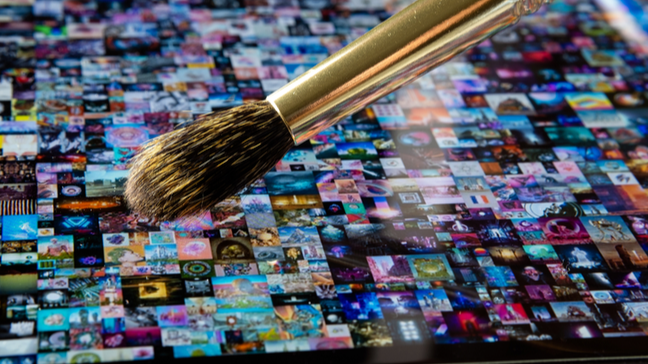
An NFT, or non-fungible token, is a data point stored in a blockchain that certifies a digital piece of media to be unique.
When you buy an NFT, you’re essentially purchasing a “certificate of ownership” of a meme, gif, piece of art, video clip, or other digital assets. You don’t own the copyright, but it’s yours, like an original painting.
There’s a lot to unpack there, so let’s start with the basics. First off, why do you often hear “NFT” and “crypto” in the same sentence?
What do NFTs have to do with cryptocurrency?
Aside from NFTs being bought with cryptocurrency, both NFTs and cryptocurrencies live on the blockchain.
NFTs, like cryptocurrencies, are stored on the blockchain
A blockchain is like a giant online ledger that records cryptocurrency transactions and other data.
Satoshi Nakamoto designed Bitcoin and blockchain at the same time; in his 2008 white paper Bitcoin: A Peer-to-Peer Electronic Cash System, he describes how Bitcoin cannot exist without blockchain. The blockchain is where Bitcoin transactions are etched in stone – legible, but also irreversible and unhackable.
An incorruptible, unified global ledger is a pretty big deal, and soon developers began asking what else can we record on there?
Such thinking gave rise to many of the “altcoins,” or non-Bitcoin cryptocurrencies. Namecoin, for example, stored IP addresses to the blockchain to stifle Internet censorship. Ethereum, launched in 2015, took a more general approach – let’s use the blockchain to record crypto transactions and…other stuff, like stocks and property records.
An altcoin called Ethereum made NFTs possible
Ethereum uses a technology called “smart contracts” to allow users to record unique strings of data to the blockchain. This enabled users to store “non-fungibles.”
You see, cryptocurrencies are “fungible” i.e. interchangeable. Every bitcoin, litecoin, and dogecoin is exactly the same. So in simple terms, the blockchain could only record amounts.
Ethereum, however, allowed you to record “notes.” These digital notes are 100% unique, making them “non-fungible” so they go by the term non-fungible tokens.
NFT technology doesn’t let you store an image to the blockchain (yet). What it does do, however, is allow you to create a unique line of data that represents a piece of art. This “proof of ownership” cannot be copied or hacked. It’s safe, unique, and resellable.
That, in a nutshell, is what an NFT is.
Why are NFTs such a big deal for artists?
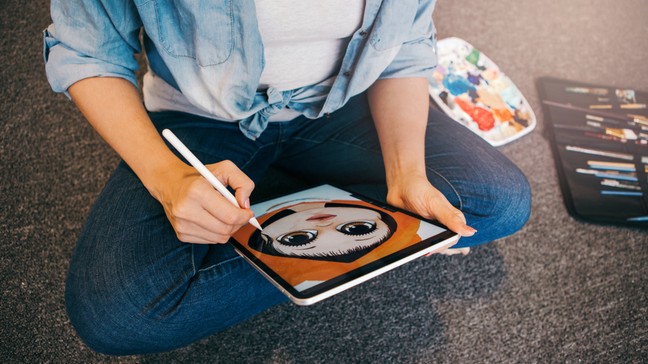
Imagine for a second that you’re a successful artist like Andy Warhol. Because you paint physical paintings, you can sell your art in two forms:
- You can sell unlimited prints of a painting for $50 each.
- You can sell the original painting itself for $50,000.
Now imagine you’re a successful graphic artist. Because your art is digital, there’s no “original” you can sell. All you can sell is licenses – the virtual equivalent of copies or prints.
NFTs change all that.
Now, as a digital artist, you can certify one of your works as “original” and sell it as an NFT. You can keep selling licenses just like you were before – but only one person holds the “original.”
Creating NFTs as “proofs of ownership” has already paid off big for some artists. Mike Winkelmann aka Beeple sold an NFT for his piece “Everydays: The First 5000 Days” for over $69 million. Countless lesser-known artists have sold their NFTs for hundreds, even thousands of dollars.
NFTs aren’t limited to images and gifs, either. NBA Top Shot sold a short video of Lebron dunking for over $200,000. Musical artist Grimes sold $6 million worth of her music videos.
Zoë Roth, the star of “Disaster Girl”, recently sold her meme as an NFT for nearly $500,000. Now aged 21, she plans to use the money to pay off her student loans and give some to charity.
Although the vast majority of NFTs sell for under $200, they still give creators of digital content an additional avenue for monetizing their creations.
How is an NFT different from copyright?
Just like buying real art, buying an NFT doesn’t entitle you to the copyright. Even if you pay $50,000 for an original Andy Warhol, you’re still not allowed to make mugs and t-shirts out of it.
All an NFT really entitles the buyer to is bragging rights. Sure, the entire Internet will keep using Nyan Cat, but you own it. For the price of a four-bedroom house, that rainbow pop-tart feline is yours.
Ownership of an NFT doesn’t entitle you to 100% of its value, either. Zoë Roth set up a 10% commission on all secondary sales of the Disaster Girl NFT. Smart! Who knows how much a piece of Internet history will be worth in 10 or 20 years?
How do you create an NFT?
Although blockchain tech is unspeakably complex, the process of creating an NFT is remarkably simple:
- Head to an NFT marketplace like OpenSea.
- Click “Create.”
- Upload your file.
- Pay your listing fee with crypto.
- List your NFT for sale.
Minus the extra step of having to buy crypto, selling an NFT is about as easy as selling something on eBay.
But if generating and selling an NFT is so easy, what’s stopping you from selling a Taylor Swift NFT for $2 million right now?
What’s stopping fraudsters from selling fake NFTs?
Not much.
In February 2021, listings for Banksy NFTs suddenly appeared on marketplaces OpenSea and Rarible.
The seller went by the username “Pest Supply,” sharing a marked resemblance to Pest Control, Banksy’s real-world legal custodian. Plus, given Banksy’s mysterious nature, a secretive NFT sale would fit his MO perfectly.
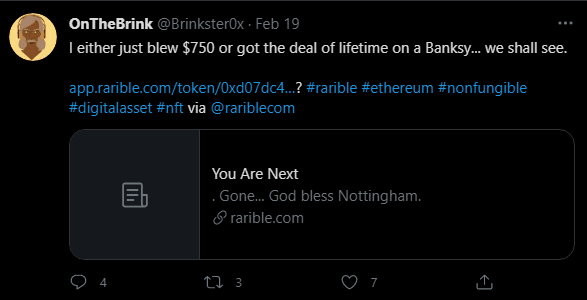
However, the real Pest Control confirmed that these NFTs had nothing to do with Banksy. But by then, the fraudster, who admitted their ploy, had already sold $1,000,000 worth.
Banksy wasn’t the first artist to suddenly discover fake NFTs of their art. In March, a fan Tweeted at Marvel Comic illustrator Derek Laufman asking him to verify the legitimacy of his artwork’s NFTs.
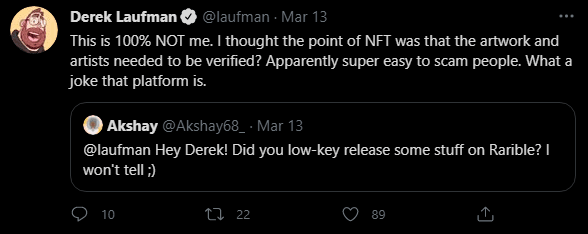
Currently, none of the major NFT marketplaces require any proof of ownership to create an NFT. Rarible and OpenSea will sometimes shut down fake seller accounts, but the scourge of fake NFT sales has raised several questions about the integrity of the whole NFT concept:
For example: if cryptocurrency transactions are non-reversible, how will victims of fraud get their money back?
Derek, like many other artists, sees NFTs as just the latest avenue for art theft. He also doesn’t hold out hope that Rarible or OpenSea will start verifying copyright anytime soon.
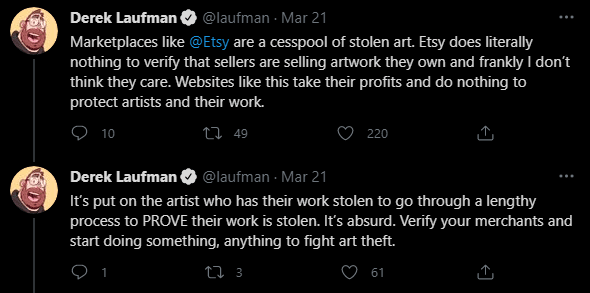
After all, Etsy has been around for 16 years and they never bothered, either.
The artistic community “loves to hate NFTs,” writes J.J. Charlesworth in ArtReview. To a subculture heavily based on progressive politics and minoritarianism, NFT’s inextricable link to crypto and its “’white bro’ culture, carbon emissions, and populist tropes” feels “awkward” at best.
He has a point about the environmental impact. The creators of Ethereum claim that NFTs technically don’t add to the blockchain’s power requirements, but that seems like an evasion. Maybe NFTs don’t, but the crypto transactions behind NFT sales surely have, and the power requirements behind 191,000 NFT sales probably haven’t planted any trees.
Like cryptocurrency itself, NFTs present both thrilling potential and real-world headaches. All things considered, should you buy one?
Should you buy an NFT?
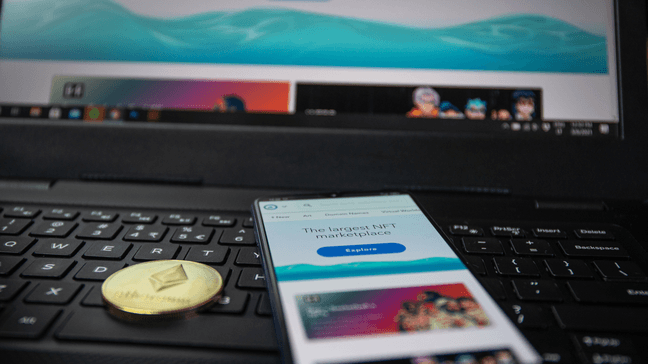
When it comes down to it, most people buy NFTs for one of two reasons.
If you want to support an artist, maybe
Some artists are selling NFTs much in the same way they’d sell real art at a fair. If you love someone’s art and want to support them, that might be a good reason to buy an NFT. Just be sure to verify it’s a real account, first.
If you want a good investment, look elsewhere
Some folks are buying up NFTs because they believe it’ll be a good investment and will sell for gobs more later.
But NFTs are so new and so surrounded by fraud and scams that you’re probably better off investing that money using tried-and-true methods.
Summary
NFTs are like “proof of ownership” certificates etched into the blockchain. They allow people to “own” digital assets like pictures, gifs, videos, and more, creating both a new source of revenue for artists and expounding on the potential of blockchain technology as a secure store of information.
But NFTs have plenty of room to grow. Aside from converting art into greenhouse gases, NFTs are a headache for artists who have little defense from fraud.
But hey – at least Disaster Girl won’t have student loan debt.